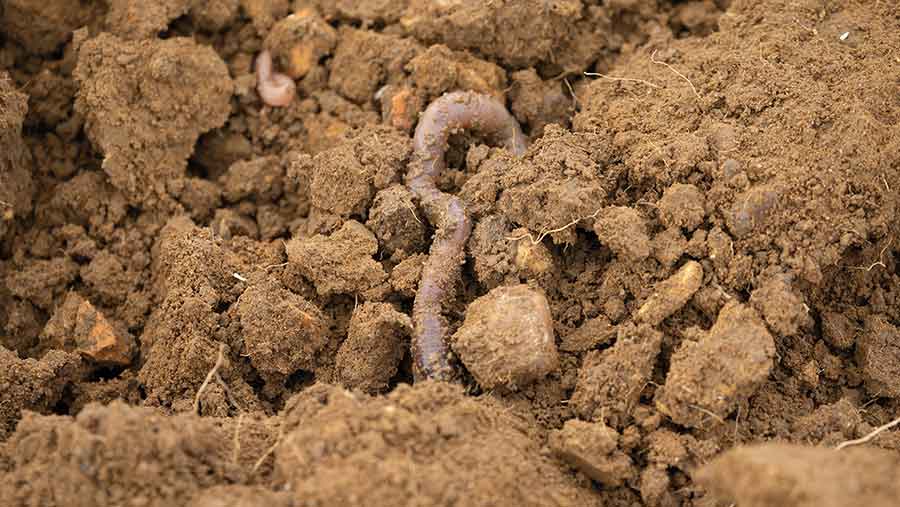Studies show earthworms can increase crop yields by 25%
 © Tim Scrivener
© Tim Scrivener Earthworms are fundamental to the delivery of a range of soil ecosystem services such as nutrient cycling and water management, which in turn affects crop development and yield.
In fact, one study states the presence of earthworms in soils can increase crop yields by an average of 25% and total crop biomass by 21%.
Often referred to as “ecosystem engineers”, earthworms stimulate plant growth, predominantly by improving soil structure and enhancing the release of nitrogen locked away in soil organic matter and residues.
See also: Could compaction-busting crops become a reality?
Another study in 2023 estimates earthworms annually contribute 6.5% of grain and 2.3% of legume production globally. This is the equivalent to 140m tonnes.
Earthworm target
Karl Ritz, emeritus professor of soil ecology at the University of Nottingham, explains how earthworms ingest soil and pass it through their bodies, gaining energy and nutrients from organic matter.
“The processed soil excreted from their rear ends is biologically very active and contains many unabsorbed nutrients, which are available for uptake by plants.
“All three earthworm ecological groups – anecic, epigeic and endogeic – have distinct burrowing behaviours.
“Under ideal conditions, deep vertically burrowing earthworms [anecic forms] can consume up to 30 times their bodyweight of soil a day,” he says.
It has been estimated that in temperate arable fields earthworms can process about 10t/ha of soil a year, while in pastures it can be at least five time this.
A further study has shown that 16 earthworms in a 20x20x20cm spade full of soil is a good indicator of biological health in terms of plant productivity and crop yield, says Karl.
Benefits
A global meta-analysis study, which revealed earthworms increase crop yields by an average of 25%, used data from 58 studies published between 1910 and 2013.
The report, published by Jan Willem van Groenigen and colleagues in 2014, suggested earthworms enhance plant growth through:
- Increased nutrient availability – particularly nitrogen
- Stimulation of microbial plant symbionts
- Soil structural changes
- Production of plant growth regulating substance
- Biocontrol of pests and diseases.
It revealed the positive effects of earthworms were stronger when greater crop residue was returned to the soil.
Conversely, associated earthworm benefits were less apparent when soil nitrogen availability was high. This was dependent on crop residue, earthworm density and type and rate of fertiliser.
Earthworm effects were strongest in clay soils and not significant in sandy soils.
The study summarised the effect of earthworms on crop production across the globe, including the three main global food crops (maize, rice and wheat), as well as grassland and other food crops.
The study noted: “Above-ground biomass was significantly increased in all crops, averaging 31% across grain crops and 24% across grassland where earthworms were present.”
Earthworm N mineralissation
The study also analysed the effect of nitrogen fertiliser rate on earthworms.
When rates exceeded 30kg N/ha, the earthworm effect decreased from 19% to 9%, suggesting earthworms stimulate plant growth by increasing N mineralisation. The N effect was not related to decomposing earthworm tissue.
Soil disturbance and pH
In experiments where soil was disturbed, the earthworm effect on above-ground biomass was almost twice as high as undisturbed soils.
The study noted: “This may reflect a beneficial effect of earthworms on restoring demolished soil structure.”
“In higher-pH soils, the earthworm effect is significantly smaller than in lower-pH soils.
“This may be a confounding effect, since the high-pH soils were often linked to systems with low or zero applications of residues or organic manure.”
The study concludes: “Future research in these systems should focus on management strategies to increase earthworm populations.
“Management practices aimed at sustainable intensification of agriculture should take into account their effect on the earthworm populations, because their presence is key to crop production.”
The full report, Earthworms increase plant production: a meta- analysis, can be found in Scientific Reports, vol. 4, 6365.

